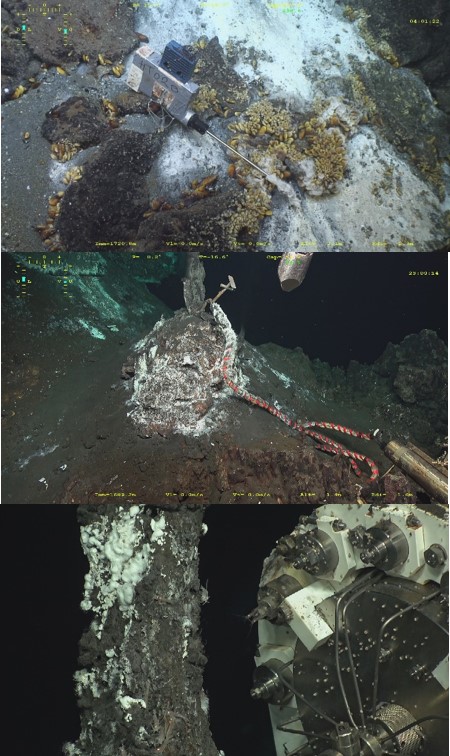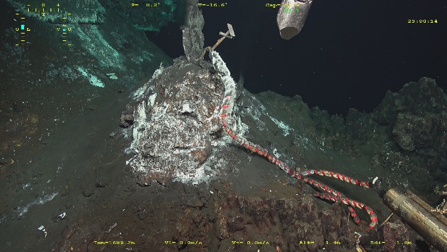[From Deep-Sea Life 16]
Sarradin Pierre-Marie¹, Matabos Marjolaine¹, Sarrazin Jozée¹, Cannat Mathilde² and the EMSO-Azores team.
¹Deep Sea Laboratory, Ifremer, Brest, France; ²Paris Globe Institute of Physics/CNRS, Paris, France
The deep-sea observatory EMSO Azores is set atop an active volcano which hosts the large active Lucky Strike hydrothermal vent field (LS – 1700 m depth). The uncabled infrastructure, comprised of two seabed monitoring nodes (SeaMoN East and West) acoustically linked to a surface relay buoy, supports several sensors on the seafloor and at the surface. Scientific and technical data are daily transmitted to the Data Centre in Brest and are available online. The nodes are completed by an array of autonomous instruments.

Every year, the MoMARSAT maintenance cruise is carried out to ensure the calibration and replacement of sensors, retrieval of complete data sets, infrastructure updates and maintenance, and energy replacement. The cruise program includes associated exploration and monitoring activities including video surveys, rock, fluids and faunal sampling and in situ experiments. Some of the most striking results obtained by our team are summarized on the EMSO website: https://www.emso-fr.org/News/EMSO-Azores-10-years-already.
In a nutshell, over the last 10 years, we have obtained decisive results to understand how the hydrothermal circulation was established, how hydrothermal fluids were formed, and what relationships were established at depth between the magmatic heat source, the permeability created by the faults and numerous fractures at the axis of the ridge, and the hydrothermal system. We also contributed to an important discovery: hydrothermal emissions from ridges play a
key role in the ocean’s iron content. Modeling currents and their interactions with topography suggested the formation of eddies that could strongly increase the spatial dispersion of particles and larvae. The study of faunal temporal dynamics highlighted the stability of vent communities on a decadal scale and allowed a better characterization of the distribution of species at the individual level, notably through the citizen science project, Deep Sea Spy. Video imagery
also allowed the multi-year 3D reconstruction of the active Eiffel Tower edifice. Most impressive, the existence of biological rhythms at the behavioral level and by molecular sequencing was revealed for the first time on a deep-sea hydrothermal species! On a smaller scale, microorganisms were shown to colonize the surfaces of basaltic glasses of the oceanic crust and to participate in their alteration.

In addition to this fundamental knowledge on the functioning of the hydrothermal ecosystem, this observatory has enabled us to develop and operate a complex infrastructure for 10 years. The electronic core of the system has been transferred to an industrial company to be commercialized, and the infrastructure developed prefigures environmental monitoring stations that could be used in the future for exploitation projects or to monitor vulnerable marine ecosystems. These technologies, and the knowledge acquired, will make it possible to respond more effectively to questions regarding the evaluation of the impacts of human activities on deep-sea ecosystems (pollution, mineral resource exploitation, etc.).

Associated publications
Barreyre T, Olive JA, Crone TJ, Sohn RA (2018) Depth-dependent permeability and heat output at basalt-hosted hydrothermal systems across mid-ocean ridge spreading rates. Geochemistry, Geophys Geosystems 19:1259–1281.
Barreyre T, Sohn RA (2016) Poroelastic response of mid-ocean ridge hydrothermal systems to ocean tidal loading: Implications for shallow permeability structure. Geophys Res Lett 43:1660–1668.
Chavagnac V, Leleu T, Fontaine F, Cannat M, Ceuleneer G, Castillo A (2018a) Spatial Variations in Vent Chemistry at the Lucky Strike Hydrothermal Field, Mid-Atlantic Ridge (37°N): Updates for Subseafloor Flow Geometry From the Newly Discovered Capelinhos Vent. Geochemistry, Geophys Geosystems 19:4444–4458.
Chavagnac V, Saleban Ali H, Jeandel C, Leleu T, Destrigneville C, Castillo A, Cotte L, Waeles M, Cathalot C, Laes-Huon A, Pelleter E, Nonnotte P, Sarradin PM, Cannat M (2018b) Sulfate minerals control dissolved rare earth element flux and Nd isotope signature of buoyant hydrothermal plume (EMSO-Azores, 37°N Mid-Atlantic Ridge). Chem Geol 499:111–125.
Escartin J, Barreyre T, Cannat M, Garcia R, Gracias N, Deschamps A, Salocchi A, Sarradin PM, Ballu V (2015) Hydrothermal activity along the slow-spreading Lucky Strike ridge segment (Mid-Atlantic Ridge): Distribution, heatflux, and geological controls. Earth Planet Sci Lett 431:173–185.
Girard F, Sarrazin J, Arnaubec A, Cannat M, Sarradin P-M, Wheeler B, Matabos M (2020) Currents and topography drive assemblage distribution on an active hydrothermal edifice. Prog Oceanogr 187.
Husson B, Sarradin P-M, Zeppilli D, Sarrazin J (2017) Picturing thermal niches and biomass of hydrothermal vent species. Deep Res Part II Top Stud Oceanogr 137:6–25.
Husson B, Sarrazin J, van Oevelen D, Sarradin PM, Soetaert K, Menesguen A (2018) Modelling the interactions of the hydrothermal mussel Bathymodiolus azoricus with vent fluid. Ecol Modell 377:35–50.
Mat AM, Sarrazin J, Markov G V., Apremont V, Dubreuil C, Eché C, Fabioux C, Klopp C, Sarradin PM, Tanguy A, Huvet A, Matabos M (2020) Biological rhythms in the deep-sea hydrothermal mussel Bathymodiolus azoricus. Nat Commun 11:1–12.
Vic C, Gula J, Roullet G, Pradillon F (2018) Dispersion of deep-sea hydrothermal vent effluents and larvae by submesoscale and tidal currents. Deep Res Part I Oceanogr Res Pap 133:1–18.

